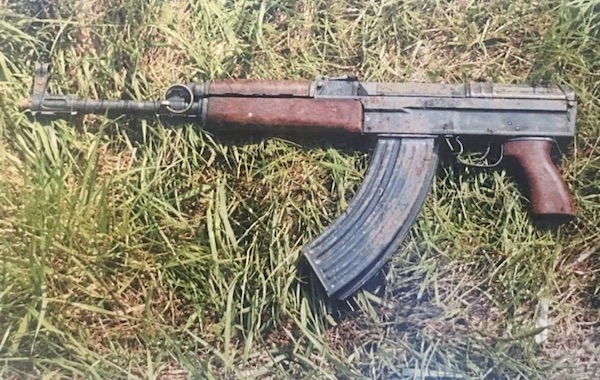
It has emerged that a single assault rifle was used by loyalists, likely including members of the British Army’s Ulster Defence Regiment, to kill up to 12 people between 1988 and 1994.
The powerful Czech-made VZ58, one of hundreds brought into the north of Ireland with the connivance of British military intelligence, was also used in the attempted murder of another two people.
Details of the gun, which had the serial number R18837, emerged during an inquest into the 1994 murder of 76-year-old Tyrone pensioner Roseanne Mallon, its final victim.
It has been linked by an Irish News report to eight different incidents in which attempts were made on the lives of nationalists and republicans. The attacks were claimed by the unionist paramilitary UVF or the Protestant Action Force, a cover name.
The history of the weapon was contained in information released at an inquest into the murder of Roseanne Mallon and reports published by the now-defunct Historical Enquiries Team (HET).
It is now suspected that some members of the British Army’s locally recruited and notoriously sectarian ‘Ulster Defence Regiment’ (UDR) used the weapon as part of a sustained terror campaign across east Tyrone and south Derry. In 1992 the regiment was rebranded and absorbed into the Royal Irish Regiment in an attempt to distance British authorities from its murderous past.
The gun was first used to kill Phelim McNally, shot dead at his brother’s home at Ballinderry in County Tyrone in November 1988. In January the following year it was used in the attempted murder of Johnny Rush in Stewartstown. Another failed gun attack took place a month later when Francis McKeown escaped with his life in Moneymore, County Derry.
Just over a year after the first murder, R18837 was again used in an attack at a bar in Moortown, in County Tyrone, on November 29 1989. IRA Volunteer Liam Ryan and local man Michael Devlin were killed when gunmen burst into the bar and opened fire. A third man was injured but crawled to safety.
The same weapon was used to claim the life of Catholic man Malachy McIvor in Stewartstown in November 1990. Several weeks earlier, in October 1990, father-of-11 Tommy Casey was shot dead near Cookstown. In March 1991, it was used in the Boyle’s Bar attack in Cappagh - the single biggest loss of life involving the weapon - which resulted in the murders of IRA volunteers John Quinn, Dwayne O’Donnell and Malcolm Nugent, and civilian Thomas Armstrong.
More than a year later, in September 1992, it featured in the brutal slaying of husband and wife Charles and Teresa Fox at their home near Moy, County Tyrone, before being used in the attack on the Mallon home in May 1994.
The gun was found under a sheet of corrugated iron during a search of a derelict house not far from the final murder scene. The stock of the deadly weapon had been removed and the letter ‘T’ and ‘UVF’ had been punched onto the rear plate.
It subsequently emerged that the Weapons and Explosives Research Centre, which was run by the murderous RUC police Special Branch, had falsely claimed the gun had no known history - a claim a coroner who presided at the Mallon inquest later said was “entirely wrong”.
The extent of the involvement of the locally-recruited UDR in the series of murders remains unclear. Relatives of people killed during the conflict have called for the activities of the regiment in east Tyrone to be investigated.
A HET report into the killing of Mr O’Donnell, released by the PSNI last year, revealed that three part-time UDR members were among four suspects arrested in December 1991.
The arrests took place “as a result of raised concerns of security service collusion in east Tyrone”, naming the ‘8 UDR’ battalion in particular.
The HET report said intelligence was received naming three soldiers as being responsible for Mr O’Donnell’s murder. It also said the UDR men “were also named as responsible for other murders”.
Briege O’Donnell, mother of Dwayne O’Donnell, said: “Given the new information revealed in our HET report and the weapons linkages, it is paramount that the involvement of the UDR and other agents of the states are fully investigated as part of this independent investigation.”
Ms O’Donnell said previous RUC investigations “failed to carry out fair and proper investigations”.
Mark Thompson from Relatives for Justice said people related to republicans were often targeted by loyalist gangs.
“Far from thwarting the activities of loyalism, which is routinely cited, this period saw a new phase of a state policy of using loyalism to target republicans and terrorise nationalists,” he said.
The importation of weapons by loyalists in the late 1980s with the apparent help of British intelligence “provided loyalism with an unprecedented capacity to wage sectarian attacks and carry out political assassinations”, he said.
“This happened at a time when the flow of intelligence documents, including personal details on republicans and nationalists, from the RUC and British army, including the UDR/RIR, to loyalists, increased significantly.”
![[Irish Republican News]](https://republican-news.org/graphics/title_gifs/rn.gif)
![[Irish Republican News]](https://republican-news.org/graphics/title_gifs/harp.gif)

